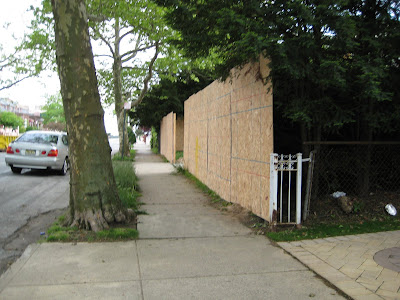I never provided an update on the information I found last week at the City Register and the Department of Finance. The City Register, as you may know, has records of the transferring of deeds. The red books only went as far back as the 1940s.
 But the purpose of my visit was to go back a step further, from 1946, to see whether there was a previous owner from whom Joseph P. Day Inc purchased the property or whether it originated as a lot under his company or Austin Corbin's. (Corbin Place was a later addition to the selling of Manhattan Beach property).
But the purpose of my visit was to go back a step further, from 1946, to see whether there was a previous owner from whom Joseph P. Day Inc purchased the property or whether it originated as a lot under his company or Austin Corbin's. (Corbin Place was a later addition to the selling of Manhattan Beach property).Older records were kept in another set of books (like the one below):
 Block 7516 was divided into an alphabetized series, as it included roughly half of the entire Manhattan Beach. The image is 7516-O.
Block 7516 was divided into an alphabetized series, as it included roughly half of the entire Manhattan Beach. The image is 7516-O.Much to my dismay, only 1/3 of the alphabet is there in the stacks. Two workers there had no information about where the rest might be and suggested that they may have been stolen even. What a shame.
Of course, the west side of Corbin Place belongs to one of the missing books so any trace to discover the house's history during the 1910-30s is lost to me. One interesting thing was to see how orderly the older books were. Typed on pages better preserved than the 1940s-1960s red block book that was hand-written.
Afterward, I ventured upstairs to the DoF with the 1946 entry's reel number to look at the actual Joseph P Day/Herman Field deed transfer. As the attendant was reading the deed aloud at the microfilm station, a man two stations away overheard and said,
"Herman Field? I knew Herman Field."
I felt I was in a mystery movie, (the Agatha Christie kind). He continued,
"Yeah, his wife was my elementary school teacher."
It turns out that this man, (maybe an expediter since he seemed so friendly with the workers there), has been living in Brighton Beach and went to school at PS 225. He explained that Herman Field was a photographer and took pictures of old Manhattan Beach and of various events or parties. He also said that Herman had a photo studio near the Lincoln Savings Bank back when stores were there and that he still has one of the photos. I was tempted to ask the man for his name but figured I could always return and ask the DoF staff. (They let him go around the counter and pull his own microfilm too.) My last question was whether he thought anyone knew of Herman Field. He waved his hand and said no, probably not.
"Not even the older Manhattan Beach residents?," I asked.
"Yeah, probably."









